My Kobumaki (Salmon Konbu Roll) is a rolled konbu (kelp) stuffed with a piece of salmon, and cooked in a sweet soy-flavoured sauce. Kobumaki is one of the Osechi Ryōri (Japanese traditional New Year feast) dishes. It is full of umami and a little bow tied around each konbu roll is so cute.
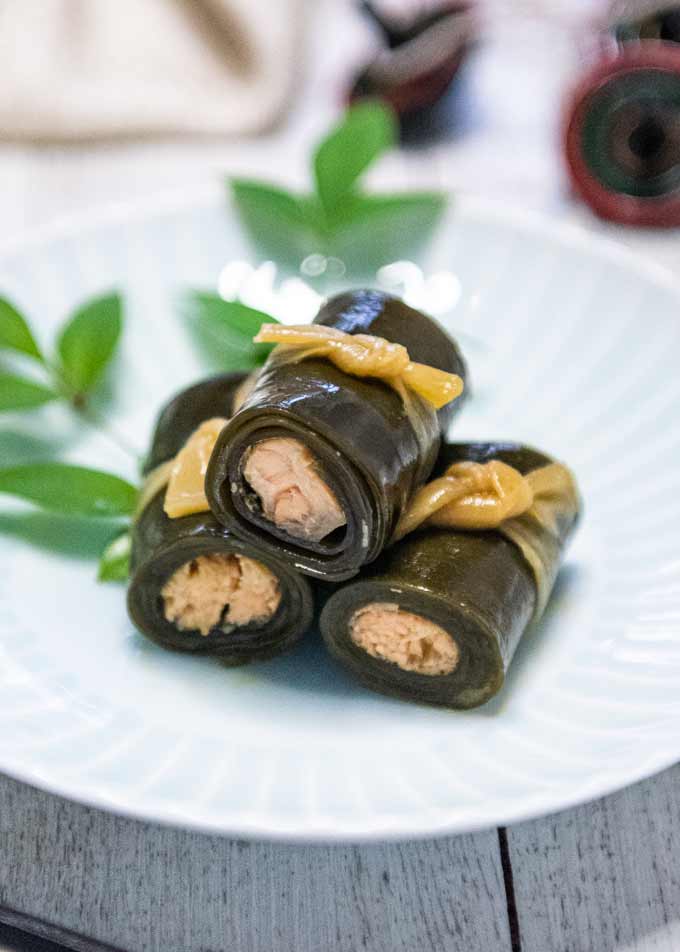
Konbu is considered to be a good luck food and is used on many happy occasions such as weddings and celebratory ceremonies. I used a piece of salmon as a filling, but you can use different ingredients for fillings. If you use vegetables such as carrot and burdock as a filling, you can make a vegetarian Kobumaki!
Kobumaki in Osechi Ryōri (New Year’s feast)
Osechi Ryōri consists of many different dishes, each of which has a specific meaning and wish for the coming year.
People eat Kobumaki to pray for happiness, longevity, and fertility. The word ‘kobumaki’ is similar in pronunciation to the word ‘yorokobu’, which means happiness. It also translates to longevity by linking the word ‘yorokobu’ to the word ‘yōrō’ (養老), meaning old age.
Kobumaki served at a New Year’s feast is traditionally stuffed with rehydrated dried herring. The Japanese word for herring is ‘nishin’ (鰊), which is interpreted as parents by using a play on words. The name of the salt-cured herring roe is ‘kazunoko’ (数の子) in Japanese and it translates to numerous children.
It sounds like a massive use of plays on words but every single dish in Osechi Ryōri has the secret meanings like this.
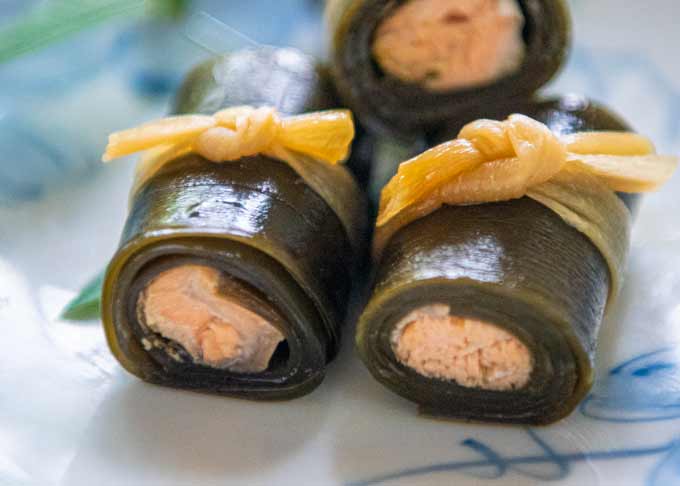
When I was little, almost every household made Kobumaki stuffed with dried herring. But these days, you will see salmon, tuna, king fish, sliced pork, and even vegetables such as burdock and carrot.
The slightly strong, sweet and salty sauce allows the dish to keep for about a week, which also makes it perfect for the New Year’s feast, which lasts 3 days.
What’s in My Kobumaki
Dried herring is not available in Sydney, so I decided to make Kobumaki using salmon as a filling.
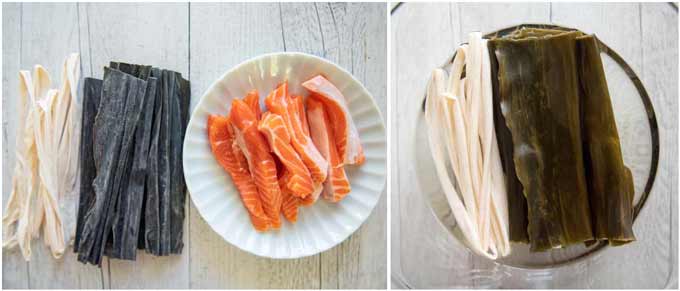
Right photo: rehydrated konbu and kanpyō.
- Dried konbu (kelp) soaked in water
- Salmon fillet
- Kanpyō (shavings made from the fruit of Lagenaria siceraria) soaked in water
I used Hidaka konbu because it is thinner than some other konbu species and it often comes in about 20cm / 8″ long strips. You can buy Hidaka konbu from Japanese grocery stores or possibly from Asian grocery stores. Other brands of konbu are OK too, including Korean konbu.
Instead of salmon, you can use other fish or meat. Or even vegetables as mentioned in the previous section.
Kanpyō is used to tie the konbu rolls. You can probably only get kanpyō from Japanese grocery stores. If you can’t get kanpyo, you can use thin strips of konbu or long dried kiriboshi daikon strips if you want edible strings. Otherwise, you can use strings of banana leaves or butcher’s twine.
Simmering Sauce
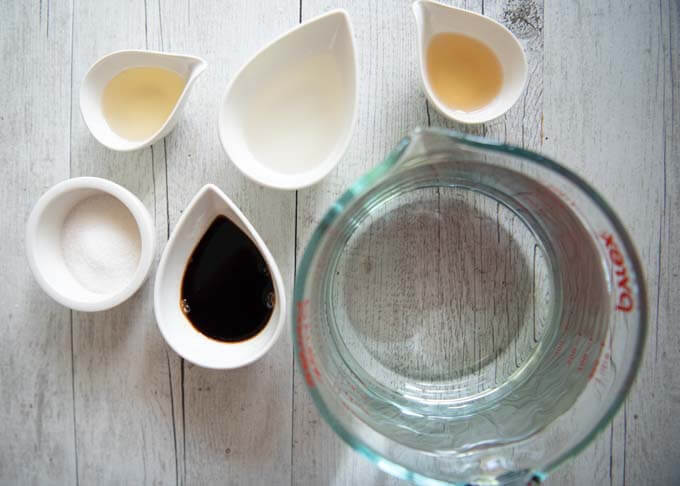
- Konbu dashi from the water used to soak konbu
- Cooking sake
- Vinegar
- Sugar
- Mirin
- Soy sauce
Vinegar makes the konbu tender, just like Nanbanzuke, where even the fish bones become tender.
Since the sauce uses konbu dashi, you can make Kobumaki a vegan dish by changing the filling to vegetables.
How to make Kobumaki
Other than making sure that you roll the konbu tightly around the salmon, there is nothing difficult about making Kobumaki.
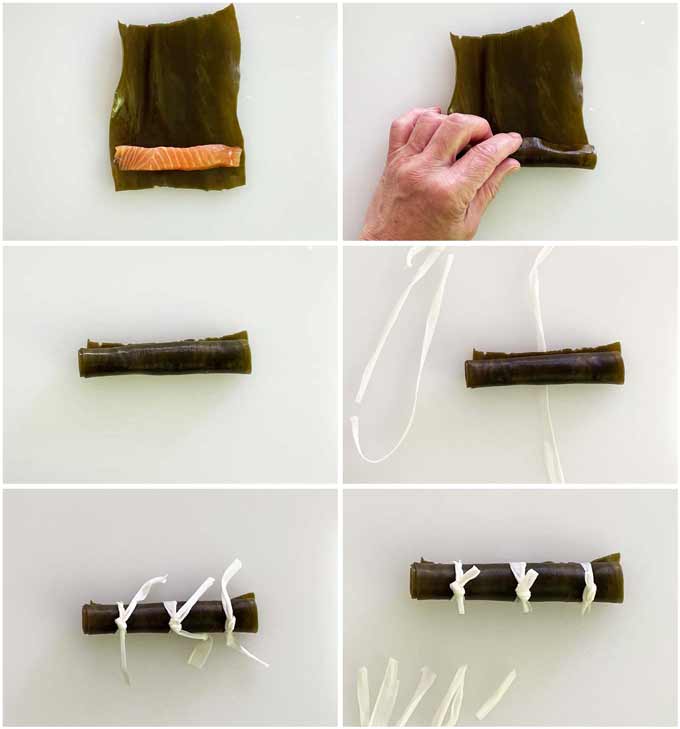
- Rehydrate konbu and kanpyō.
- Cut salmon into sticks.
- Roll konbu with a piece of salmon stick in the middle.
- Tie the roll with a piece of kanpyō in 2-3 places depending on the width of the konbu.
- Cook the konbu rolls in the sauce until the sauce is almost evaporated.
- Cut each kombu roll between the kanpyō knots.
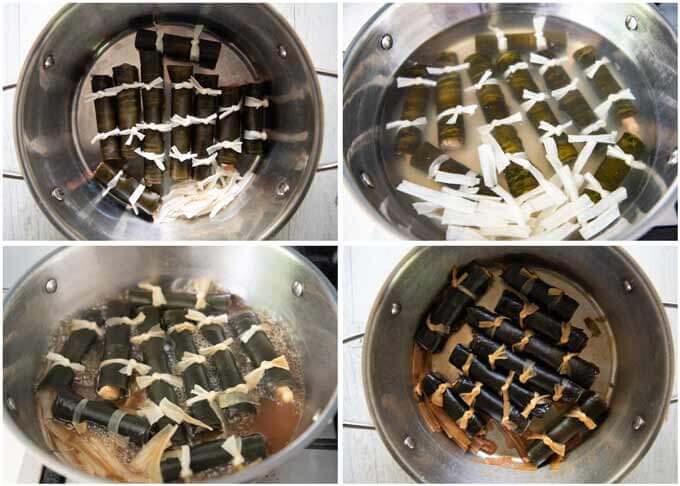
Reducing the sauce determines the flavour strength. I am not fond of overly strong flavours so I tend to finish cooking the konbu rolls with a slight amount of sauce still in the pot (unlike the step-by-step photo above).
If all the konbu sheets came in the same width and length, your life would be easier and the size of your Kobumaki would be all the same.
My konbu came in similar lengths but the width varied. As you can see in the photo above, I had to tie some rolls in two places and some in three places.
You will most likely end up with different sized Kobumaki, but that’s OK for home-cooking. If I were to serve Kobumaki on special occasions, I would try to make all of the Kobumaki the same size.
You can serve Kobumaki either in the way you lay the logs or placing them upright like the photo below.

Kobumaki is a perfect side dish for a bento box. You can freeze them too.
Yumiko![]()
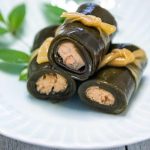
My Kobumaki (Salmon Konbu Roll) is a rolled konbu (kelp) stuffed with a piece of salmon, cooked in a sweet soy-flavoured sauce. Kobumaki is one of the Osechi Ryōri (Japanese traditional New Year feast) dishes.
If you replace salmon with vegetables such as carrot and burdock, it becomes vegetarian.
Don't forget to see the section 'MEAL IDEAS' below the recipe card! It gives you a list of dishes that I have already posted and this recipe that can make up a complete meal. I hope it is of help to you.
- 40-50g / 1.4-1.8oz dried konbu (20cm / 8" long, minimum 8cm / 3⅛" wide when rehydrated, note 1)
- 200g / 7.1oz salmon fillet cut into 2cm x 2cm / ¾" x ¾" wide , 8-10cm / 3⅛-3 5⁄16" long sticks (note 2)
- 15g / 0.5oz kanpyō (note 3)
- 1000ml / 2.1pt konbu dashi (water from soaking konbu + water if not enough)
- 2 tbsp cooking sake
- 1 tbsp vinegar
- 2 tbsp sugar
- 2 tbsp mirin
- 2 tbsp soy sauce
-
Rehydrate konbu and kanpyō in individual bowl filled with water for 30 minutes.
-
Remove the konbu from water and keep the water. Pat dry konbu sheets.
-
Squeeze the water out of the kanpyō and cut the string into 16-18cm / 6¼-7" long lengths. If the string is wider than 1cm / ⅜”, halve the string vertically and make two narrow strings (note 4).
-
Place a sheet of konbu on a cutting board, with the short edge closest to you (note 5).
-
Place a piece of salmon on the edge of the konbu closest to you. If the salmon is too long, trim the excess off. If it is too short, cut a short piece from another salmon piece and link it to the first piece of salmon on the konbu.
-
Starting from the end where the salmon is placed, roll the konbu gently but tightly, moving away from you, until the roll reaches to the other end. Place the end of the roll facing down.
-
Using kanpyo strings, tie (firmly but not too tightly) the roll in 2-3 places, positioning the knot so that the knot will be centred when the konbu roll is cut into equal sizes later (note 6).
-
Trim the excess string after making a knot so that it makes a little bow.
-
Repeat the process to make konbu rolls with the remaining konbu sheets.
-
Place the konbu rolls in a shallow saucepan in one layer, facing the end of the roll down, i.e., with the knot facing up. You can also throw in the kanpyō bits that you got when the end of the string was trimmed after making knots.
-
Add konbu dashi, cooking sake and vinegar to the pan and bring it to a boil. If scum comes up, remove.
-
Reduce the heat to low, place a drop lid over and cook for 30 minutes.
-
Remove the drop lid, add the rest of the Simmering Sauce ingredients to the pot.
-
Put the drop lid back on and continue to cook for about 10-15 minutes or until the sauce reduces to almost none left (note 7). Shake the pot from time to time to coat the konbu rolls with the sauce evenly.
-
Turn the heat off and cool it down.
-
Place the Kobumaki on a cutting board and cut each roll between the knots, into 2 or 3 equal size pieces (depending on how many knots you have on a roll).
-
Serve in a large plate to share or few rolls individually (note 8).
1. I had 9 sheets of konbu of various widths. It is very difficult to specify exactly how many sheets you get because every sheet of konbu is a different thickness and size. It does not matter even if you have more/less number of sheets.
If your konbu is very long and wide, you can cut it into the required size. If your konbu is narrower than 8cm / 3⅛" after rehydrating, that’s OK. You can use two sheets to make it wider.
2. The quantity of salmon required is also approximate because it depends on how many konbu you have and how wide each konbu is.
3. One pack of kanpyō that I bought included 2 long strings of dried kanpyo. 1 string weighed about 15g / 0.5oz before rehydrating.
The quantity of kanpyō listed is probably more than is required for the number of konbu rolls, but it is better to have too many than not enough strings to tie all the rolls.
Instead of kanpyō, you can use thin strips of konbu or long dried kiriboshi daikon strips. These alternatives are edible. Otherwise, you can use strings of banana leaves or butcher’s twine, but don’t eat them.
4. Since the width of long kanpyō strips is not consistent, you will find that some are wider than others. If the string is too wide, Kobumaki does not look good. Wide string is also harder to make a knot with.
5. If your konbu is narrower than 8cm, place two sheets next each other, overlapping about 2-3cm / ¾-1⅛". When you tie the roll, you need to tie the overlapping area to secure the two konbu sheets.
6. If your konbu is about 8cm / 3⅛" wide, tie the roll with kanpyo string in two places, i.e., 2cm / ¾" from both ends. If your konbu is around 12cm wide, you need to make 3 knots, i.e., 2cm / ¾" from both ends and the middle. As a guide, you will need one knot per 4cm / 1½" of konbu roll. If the width of your konbu is between 8cm / 3⅛" and 12cm, you will need to make a judgement call as to whether you want to make longer Kobumaki or shorter ones.
7. Time taken to reduce the liquid varies depending on the heat, size of your saucepan.
8. Kanpyō bits can be put next to the Kobumaki, if you like. Alternatively you can freeze them, then use as a filling for Sushi Rolls or mix into sushi rice when making Chirashi Sushi.
9. Nutrition per piece of Kobumaki (I made 21 pieces with the above ingredients).
serving: 66g calories: 41kcal fat: 1.7g (3%) saturated fat: 0.4g (2%) trans fat: 0.0g polyunsaturated fat: 0.4g monounsaturated fat: 0.5g cholesterol: 5.7mg (2%) sodium: 167mg (7%) potassium: 124mg (3%%) carbohydrates: 2.7g (0.01%) dietary fibre: 0g (0%) sugar: 1.8g protein: 3.2g vitamin a: 1% vitamin c: 0.8% calcium: 0.5% iron: 0.7%
Meal Ideas
A typical Japanese meal consists of a main dish, a couple of side dishes, a soup and rice. I try to come up with a combination of dishes with a variety of flavours, colours, textures and make-ahead dishes.
Kobumaki is one of the dishes served at New Year’s feasts (Osechi Ryōri). So, I thought it might be a good idea to list a collection of dishes that I have already posted and are served at New Year’s feasts.
It is nowhere near the entire set of Osechi Ryōri, but even if you are serving just these dishes, you can impress your diners!
Each dish in Osechi Ryōri has a specific meaning or embedded wishes. I added brief meanings against each food.
- Japanese-style Grilled Snapper – associated with celebrations.
- Kobumaki (Salmon Konbu Roll) – today’s recipe, associated with longevity and blessed with children.
- Japanese Chicken Meatloaf (Noshidori) – links to celebratory events as well as honesty.
- Pickled Chrysanthemum Radish – chrysanthemum is said to get rid of evil.
- Simmered Vegetables (Nishime) – happy family.
- Pounded Burdock Root with Sesame Sauce (Tataki Gobō) – is for good luck.
- Ozōni (Clear Soup with Rice Cake) – longivity (comes from the fact that a cooked rice cake stretches a lot).
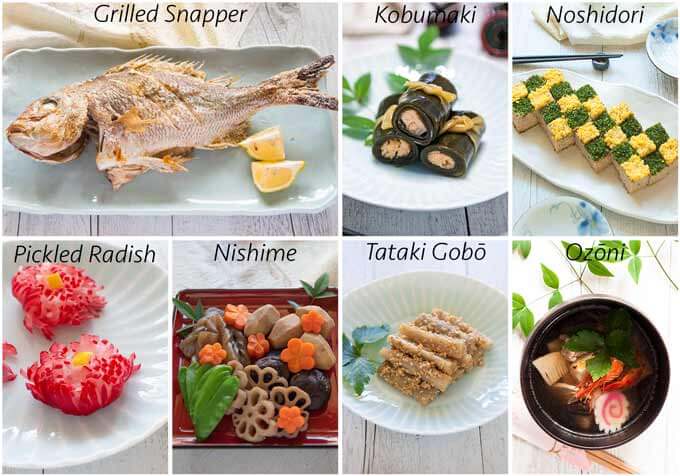
Great recipe, thanks for sharing! Is there a particular japanese grocery shop in Sydney that stocks the hidaka kombu please? Many thanks.
Hi Melissa, I bought it from Tokyo Mart in North Bridge. Other Japanese grocery store such as Lucky Mart in Artarmon might stock it too. You may want to call them first.